Embark on a journey to uncover the secrets behind The Software Behind the World’s Prettiest AI Women. Dive into the realm of technology and design as we explore the fascinating world of creating visually stunning AI characters that captivate and inspire.
Discover the intricate process of developing AI women, from coding to graphic design integration, and the ethical considerations that shape their portrayal in software.
Overview of AI Women's Design

AI women in software refer to virtual characters or assistants that are designed to have female characteristics and features. These AI women are created using advanced algorithms and technologies to simulate human-like interactions and responses. Creating aesthetically pleasing AI women is significant as it enhances user experience and engagement.
Visual appeal plays a crucial role in attracting users and making the AI women more relatable and approachable. The design of AI women involves careful consideration of factors such as facial expressions, body language, and overall appearance to ensure a realistic and appealing virtual character.
The Role of Design in Developing Visually Appealing AI Characters
Design plays a vital role in developing visually appealing AI characters as it influences how users perceive and interact with the AI women. The design elements such as color schemes, graphics, animations, and user interface contribute to creating a captivating and engaging experience for users.
Effective design helps in establishing a strong emotional connection between users and AI women, making the interactions more meaningful and enjoyable. By focusing on aesthetics and user-centric design, developers can enhance the overall usability and effectiveness of AI women in various applications and platforms.
Software Development Process
When it comes to creating AI women, the software development process involves several stages that bring together programming, design, and AI technology. These stages are crucial in shaping the final product and ensuring a seamless integration of AI characters into various applications.
Programming Languages for AI Character Design
- Python: Python is widely used in AI development due to its simplicity and versatility. It offers a wide range of libraries and frameworks that are essential for creating AI women with intricate personalities and behaviors.
- Java: Java is another popular programming language for AI character design. Its strong object-oriented programming capabilities make it suitable for developing complex AI systems with well-defined structures.
- C++: For more performance-intensive AI applications, C++ is often utilized. Its speed and efficiency are beneficial in creating AI women that require real-time interactions and processing.
Integration of Graphic Design Elements
Graphic design elements play a crucial role in enhancing the visual appeal and personality of AI women. These elements are integrated into AI software through a combination of programming languages and design tools to create a seamless user experience.
By incorporating graphic design elements such as facial expressions, body movements, and clothing styles, AI women can exhibit lifelike behaviors and emotions that resonate with users.
AI Algorithms and Visual Representation
AI algorithms play a crucial role in generating the appearance of AI women, combining realism and stylization to create visually appealing characters. These algorithms are responsible for learning how to create lifelike visuals that captivate the audience.
Algorithms for Visual Creation
- Generative Adversarial Networks (GANs): GANs are commonly used to generate realistic images by pitting two neural networks against each other – a generator and a discriminator. The generator creates images, while the discriminator evaluates them for realism. Through this adversarial process, GANs can produce high-quality visuals.
- Style Transfer: Style transfer algorithms allow AI systems to mimic the artistic style of reference images, enabling the creation of unique and visually striking characters. By transferring the style of one image onto another, AI systems can achieve a balance between realism and stylization.
- Deep Learning: Deep learning techniques, such as convolutional neural networks (CNNs), are utilized to analyze and extract features from images. This enables AI systems to understand visual patterns and details, contributing to the creation of realistic AI women.
Learning Realism in AI Systems
- Training Data: AI systems learn to create realistic visuals through exposure to vast amounts of training data. By analyzing diverse images, these systems can understand the nuances of human features and expressions, enhancing the realism of AI women.
- Feedback Loops: Feedback loops are crucial for refining the visual output of AI systems. By receiving feedback on generated images, these systems can continuously improve their ability to create lifelike characters, striking a balance between realism and stylization.
Balancing Realism and Stylization
- Artistic Interpretation: AI designers play a key role in balancing realism and stylization in AI character design. By incorporating artistic interpretations and creative choices, designers can enhance the visual appeal of AI women while maintaining a sense of realism.
- User Preferences: Understanding user preferences is essential for achieving the right balance between realism and stylization. By considering user feedback and aesthetic preferences, AI systems can tailor the appearance of AI women to resonate with their audience.
Ethical Considerations in AI Design

As technology continues to advance, it is essential to address the ethical considerations that come with designing AI women in software. The portrayal of AI characters, particularly women, raises concerns about objectification, stereotyping, and the perpetuation of harmful biases.
Impact of Biased Algorithms on Representation
Biased algorithms used in AI design can have a significant impact on the representation of AI characters, especially women. These biases can stem from the data used to train the AI models, leading to skewed depictions that reinforce societal stereotypes.
For example, if the training data is predominantly focused on a specific demographic, the resulting AI character may lack diversity and inclusivity.
Strategies for Diversity and Inclusivity
To ensure diversity and inclusivity in AI character design, developers must actively work to mitigate biases in algorithms. One strategy is to diversify the training data by including a wide range of voices and perspectives. Additionally, incorporating ethical guidelines and principles into the design process can help identify and address potential biases before they manifest in the final product.
Engaging with diverse communities and seeking feedback from marginalized groups can also provide valuable insights for creating more inclusive AI characters.
End of Discussion

In conclusion, The Software Behind the World’s Prettiest AI Women showcases the blend of artistry and technology in crafting AI characters that push the boundaries of creativity and innovation. Dive deeper into this mesmerizing world where beauty meets intelligence, leaving us in awe of the endless possibilities in AI design.
FAQ
How are AI women designed in software?
AI women are designed through a meticulous process involving coding, graphic design, and algorithmic generation to create aesthetically pleasing characters.
What programming languages are commonly used for AI character design?
Commonly used programming languages for designing AI characters include Python, Java, and C++. Each language offers unique capabilities for creating intricate AI designs.
How do AI systems learn to create realistic visuals?
AI systems learn to create realistic visuals through machine learning algorithms that analyze vast amounts of data to understand patterns and trends in visual representation.
What ethical considerations are important in AI character design?
Ethical considerations in AI character design revolve around ensuring diversity, inclusivity, and avoiding biased algorithms that may impact the portrayal of AI characters in software.










